Farrier Takeaways
- Don’t shortcut the time required to thoroughly evaluate higher-end sport horses before shoeing them.
- Keep notes on your observations and shoeing choices with each horse, and refer to them to measure progress.
- Think of the impact on the horse before dramatically altering the shoeing, especially if leading into a show.
- Grooms can be valuable allies — treat them with respect and they may be sources of horse information the trainer might miss.
Farriery is in the Galli family blood. The family’s shoeing legacy dates back to Fondi, Italy, when blacksmith Orazio Savocchio immigrated to Millbrook, N.Y., in the early 20th century. He changed his name to Galli — another family’s name back in Fondi — because the longer name was difficult for non-Italians to spell or pronounce. His son Louis continued into the trade, later passing the torch to his son Paul. Fourth-generation farrier Justin Galli carries on the family tradition, following his father into the trade about 25 years ago.
Justin Galli spent about 6 years learning under his father before venturing out on his own. He recognizes the advantage this provided him because the early mistakes made as an inexperienced farrier rather than working under a respected farrier with high-end hunters and jumpers. A damaged reputation in that world would be difficult to recover from and succeed. Looking back, the younger Galli says those early years also taught him valuable lessons other than those learned under the horse.
“Working with him helped me understand how to set up and how to run it successfully,” he says.
The guidance paid off. Galli is now leading a successful hunter/jumper/dressage practice based in southeast New York. On this “Shoeing for a Living” day, he not only shared his perspective on hoof care, but revealed how business principles in communication, staffing and delegation drive his daily operation.
On the Road Again
Galli first makes a quick stop to drop off supplies at Double H Farm in Ridgefield, Conn. The client is shipping horses to Texas for show season, so Galli has packed a rolling storage trunk with hand tools, shoes and other supplies. The shipment will be on site when he flies to the Lone Star State to shoe the horses. He’ll use a Bay Horse Innovations cart equipped with a forge, anvil, power tools and storage space.
Galli’s practice primarily is in New York and Connecticut, and Wellington, Fla., during show season. It has been several tough months following clients who’ve been traveling in response to rescheduled or alternative shows. Galli had hoped to travel less, but he’ll make the trip to keep a good client.
LEARN MORE
See video highlights from the day with Justin Galli showing his work to help prepare horses for the show ring at
AmericanFarriers.com/0121
Be Flexible to Work the Show Circuit
Galli pulls his Chevrolet Silverado 2500 and shoeing trailer outside the barn at Findlay’s Ridge in North Salem, N.Y. Show horse farriers are accustomed to planning around clients’ schedules, but today’s work is indicative of how COVID-19 has disrupted the show circuit. The Findlay’s Ridge crew has been on the road for several months straight, dealing with postponements, relocations and rescheduled shows. Galli’s done some unusual travel to keep up with their horses’ hoof care. He’ll need to set up these horses for an upcoming show and then determine whether they will come back here or head down to Wellington for the show season.
Galli says even under normal circumstances a show horse farrier needs a laid-back approach. He acknowledges that the team is back for a week after being on the road since November, so he must be flexible to fit their show schedule.
The stable typically will have between 25 to 35 horses at a given time. Galli says to manage accounts like these, you need to rely on a team. For example, if the manager says they have 12 rather than the expected 10 on a day, it is more manageable with other farriers. Joining Galli today is Joseph Mustello, who has been with Galli Forge since 2015. Farriers Mike Mosher and Melvin Rivera work with the business on certain days as well.
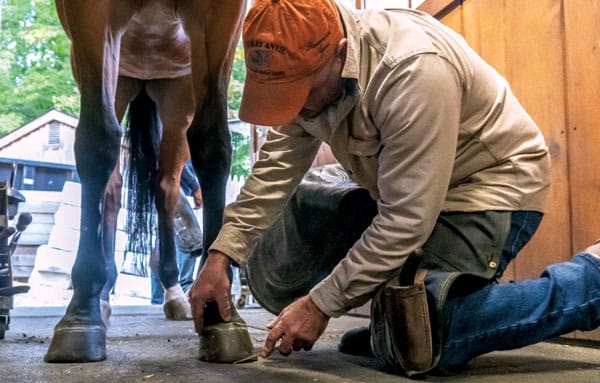

Measuring feet (left) and watching each horse walk (right) are two tools Galli uses with other information he gathers to reach informed decisions on trimming and shoeing.
Take the Time to Observe
Mustello hand walks the first horse, Elinea, while Galli looks on. Galli likes to watch each horse move before he starts shoeing because of all the information he can learn just through observation. But that is just one of the pieces of the puzzle.
“I first watch the horse walk to see how it is landing,” he says. “If it is a horse I shoe often, I’ll know its conformation. You should know the conformation. If you don’t take the time and then have a discussion with a vet on why you didn’t give the toed-in horse more lateral support, it isn’t a good feeling as a professional. Watching the horse isn’t everything, but it is one of the steps we take to evaluate.”
When planning a day, Galli structures it to balance being aware of the time, but not to where the horse gets cheated. If it takes longer to shoe a horse, Galli says they’ll make the time.
Galli recommends taking your time with this level of horse. If you don’t, you won’t survive. The competition is too stiff in this industry.
Protect, don’t Correct
Galli has shod Elinea a few times — the last being on the road in Kentucky. After Mustello pulls the shoes, Galli takes his hoof knife to the right forefoot. He notes that there isn’t substantial growth after 4 weeks and stresses restraint in trimming.
“I like to use the word ‘mass,’” he says. It’s something he picked up from his father. “Leave these horses some mass. They show too much to take out too much foot.”
Moving onto the jumper’s left fore, he gives credit to the grooms at Findlay’s Ridge. Not only do they alert him to issues with the horses, but provide maintenance to the feet because of how often they show. The Epsom-salt-based products used by grooms can harden feet, but not to an unhealthy degree. At a barn like this, each groom is in charge of three to four horses.
“We see the horse for an hour, maybe 2 hours per month,” Galli says. “The grooms are with them 10 hours a day. If a trainer doesn’t feel something with a horse, the groom may notice it.”
Galli will reset the front steel Kerckhaert clipped Comforts. While they are in the forge, Galli reads the shoe wear on the left hind. He’s happy seeing uniform wear, maybe slightly more wear to the lateral side, but nothing to be concerned over. Much like watching the horse walk, examining wear doesn’t tell the whole story, but contributes to understanding the horse’s needs.
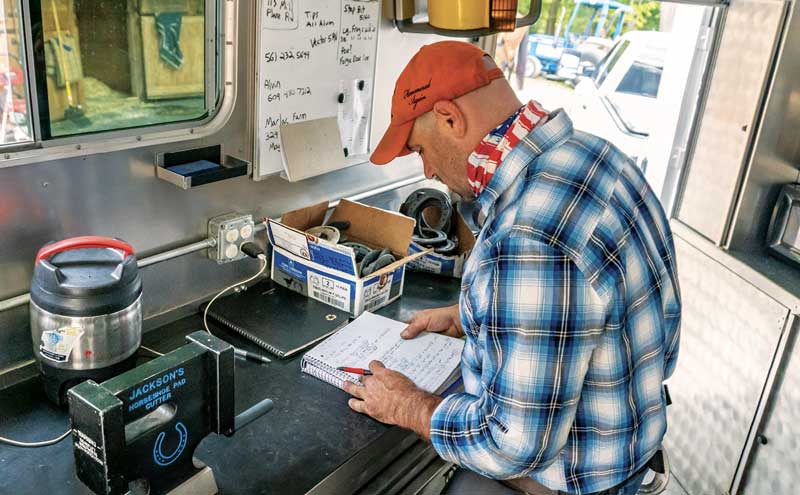
Galli writes notes on his horses throughout the day, then transfers these to iForge Ahead records.
Galli flattens the left front shoe, considering the mechanics he puts into it. This horse has good integrity to the foot, and there’s already slight rockering built into the shoe, so he rolls the toe. On shoe selection, Galli says he typically likes wider width in the front heels with these horses.
“These decisions come from the evaluation — watching the horse walk, getting feedback from the rider or trainer and looking at the shoe wear,” he says. “Your evaluation should dictate what you do to the shoe.
“Rarely in our business are we trying to correct anything, other than young horses,” he says. “These horses are all full-grown, so as the saying goes, ‘We don’t correct the foot, we protect the foot.’ The majority of the horses we work on don’t have ideal conformation, and we have to roll with what the horse is. If the horse wants to turn out a little bit, I make it easier for him. Don’t try to make it where the horse looks better by trying to turn him in.”
Galli takes a look at Mustello’s hind trim, noting it is in the parameters of what they want — no excess toe and retaining the all-important mass. The right hind has some slight medial and lateral hoof wall separation, so Galli dries it out with Thrush Buster. Similarly, he says that in a straightforward case like this horse, he’ll let one of the other farriers shape the shoe. Galli finds letting the crew make these decisions keeps them motivated.
Galli drills and taps the hinds, saying he does this for most of his horses, even when the client doesn’t ask for stud holes. With the tacky synthetic surfaces, he finds more clients aren’t using studs as they had previously. It’s always important to consider where the horses are going to show. You may have a horse train on a grass jump course, even if an upcoming show uses a synthetic surface.
“You don’t want the client to call after the fact and say that the horse now needs the stud holes,” he says.
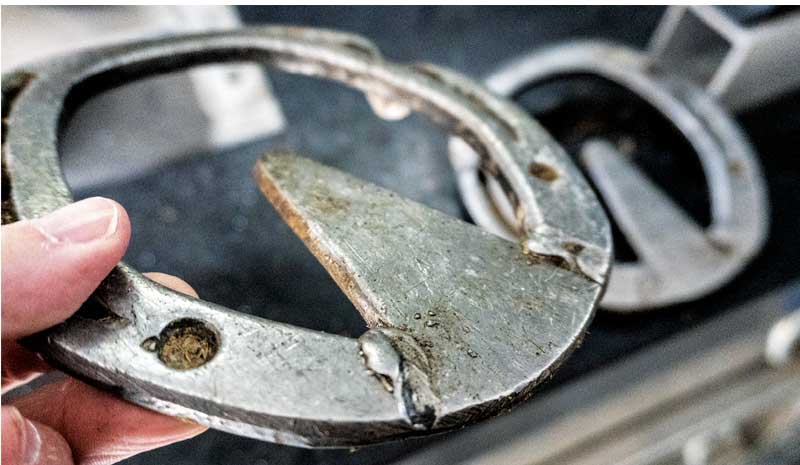
After pulling the heart-bar shoes from a horse recently acquired by the barn, Galli decides he will get one more reset. Changing shoeing styles without knowing the cause for using these shoes can introduce a problem.
Build a Network
With the grooms moving on to other chores, Mustello and Galli will get a hunter in the crossties. First, Galli watches Esprit walk, noting the left forefoot turns in while landing, putting weight on the lateral side.
The horse was last shod for Galli at a show by Lexington, Ky., farrier Greg Beiting. To manage horses on the circuit, especially with changing show schedules, it is helpful to have a network of farriers who trust each other’s work and fill in. Galli says if you’re helping someone out, take a minute to call and discuss the horse.
“If I’m going to do a horse for someone, I’ll touch base to make sure I understand what they want and anything I should know about the horse,” he says.
As Mustello finishes Elinea, Galli shapes the Werkman Ryders for Esprit’s hinds. He notes the slight rockered toe to ease breakover because the horse receives hock and stifle injections.
With new horses, he’ll first talk with the trainer or barn manager to see whether there is anything to know about the horse’s health history, like the injections.
If working alone, Galli prefers starting on the forefeet, acknowledging farriers have particular pros and cons for working around a horse. If there is a lameness concern, Galli likes to start at that end because it may help him see the immediate effects of the work on that end. He adds that watching the horse on the floor after working on it can reveal more.
“I want to monitor it so I can see how the horse is responding on that end,” he says.
Watching the horse isn’t everything, but it is one of the steps we take to evaluate …
As Galli hot fits the left hind foot, he notes that it is a bit wide, which he suspected at the anvil.
“Trust your judgment if things don’t look right before you head to the horse,” he suggests.
Looking at the front feet, Galli wants to try some different shoes, measuring the sample against the feet. Galli says shoe selection is something he doesn’t take lightly, especially with a new horse. He says when he was starting out, this was a trait his father had, which annoyed the younger Galli. Today, he appreciates the exercise, rather than simply sticking with whatever the horse wore last time.
Galli says he rarely dresses feet from the top before fitting. He’ll address a flare, but he’s more worried about preserving hoof wall strength.
“I do more dressing from the bottom of the foot at this stage of my career because I’m avoiding thinning the walls,” he adds.
Galli opted for Mustad aluminum Equi-Libriums on the forefeet. He likes the wider web on the shoe and breakover already built in. He notes that he’s seen some recent veterinary preference for the shoe. In terms of veterinarian-farrier relations, Galli says his view is to build trust with the vet. Once he earns that, he doesn’t receive as many requests for specific shoe brands. Instead, they address shoeing principles. Galli never has an allegiance to one type of brand, especially when addressing therapeutic needs.
“I’d rather make an asymmetrical shoe because I think a premade shoe ties you in,” he says. “If they don’t drop on the foot, it won’t help a horse.”
Fitting the shoe to the right forefoot, Galli notes how the footwear tells more about the horse’s conformation.
“Even by watching her walk before, I need to help the lateral side,” he says. “Just enough, but not to overdo it. Wider and longer is not always better. Again, we don’t correct, we protect — and here with just enough lateral support.”
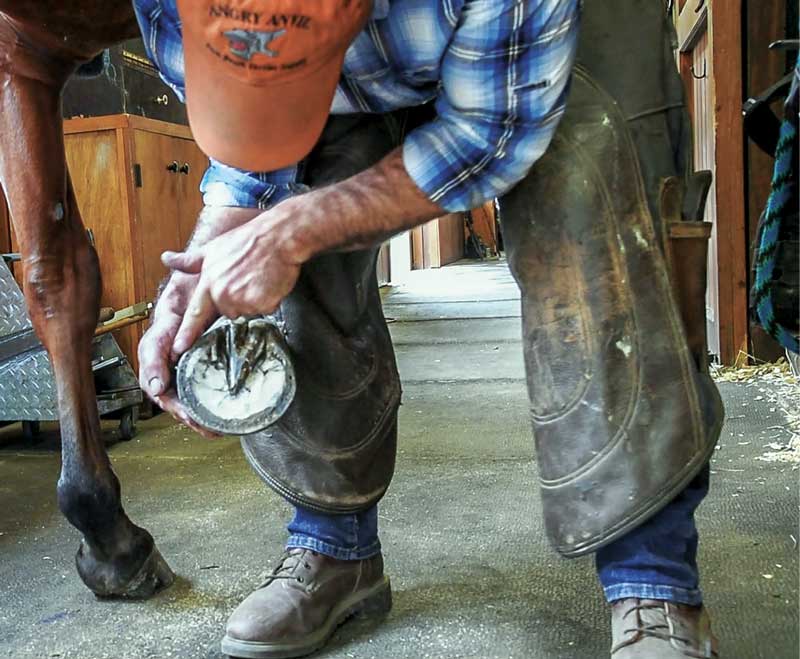
Galli reads the foot to make sure his shoe and modifications benefit the horse for its conformation.
Using Pads
Mustello walks Duty, the next show hunter they’ll work on. After Galli watches, he finishes nailing Esprit so Mustello can finish her.
Galli has shod Duty a few times. As he pulls the aluminum Kerckhaert Century shoes off the fronts, he says that he’s found the addition of rim pads beneficial with this horse so far. Although not so much with today’s horses, he likes using pads. Galli has seen many horses benefit from rim pads to lift the horse and gain sole depth. He’ll switch to Equi-Libriums for this shoeing to see whether there will be an improvement.
“Plus, many clients like access to the feet for packing, so they would prefer not using a full pad,” he says, adding that if he needs to use a full pad, they won’t object to his decision.
Before Esprit goes back to the stall, Galli hand walks her again and then takes hoof testers to the front left foot. He uses testers often as part of his overall evaluation because these horses travel and are worked frequently. He doesn’t find any concerning reaction.
Galli fits and nails the rim pads and shoes onto Duty. He taps in the clips, noting he sets the clips on aluminum after nailing them on because he gets a better fit with aluminum if he leaves the clips out a bit. Galli doesn’t like working aluminum too hot, so he won’t get the burn that he would setting steel clips.
Asked about nailing, Galli says he isn’t obsessive, but prefers a high nail. He feels there is sufficient foot to nail high into the hoof wall without getting a hot nail. Mustello trims the hinds while Galli works the front end. After finishing nailing the forefeet, Galli watches the next horse walk.
Following Another Farrier’s Work
Tokyo is a show hunter that came to Galli’s practice wearing heart bars. He wasn’t aware of what the issue was that led the previous farrier to nail them on, nor was the barn aware of any shoeing history with the horse. It initially wasn’t a concern because the horse was a short-term lease and a one-time shoeing in Kentucky. But now that the lease turned into a purchase, Galli is curious. Without the history and with the horse going back out on the road, he is hesitant to take the horse out of the heart bars.
Although the shoer is unknown, Galli compliments the previous workmanship. Showing the heart bar worn on the more upright foot, the farrier selected a #4 Kerckhaert DF, which is 10 mm thick. The welds were done well, and the frog plate is slightly thinner than 10 mm, but the previous farrier used the thickness and welded the bar lower because the heels are high.
“It is nice to follow another farrier who takes their time and shows pride in their work,” Galli says.
Galli goes to his Bay Horse trailer to jot down notes in his day planner. Keeping notes are a key part of his practice. He includes minute details, such as when a right front is slightly larger than the left front. He’ll log the notes more thoroughly at the end of the day into iForge Ahead by transferring them from his day planner. Galli will often refer back to notes and analyze the shoeing history, especially over seasons. He finds this can provide critical information on how to best help the horse’s footcare. When working in this discipline and in sales barns, most farriers can’t recall detailed information from memory.
Still in the trailer, Galli says one simple change to his storage is placing shoes in the drawers.
Seldom used shoes are stored on racks in drawers, but the frequently used stock is kept in boxes. It results in less time loading the trailer and tracing inventory for everyday use.
Of course, there can be overuse or misuse of heart bars, but Galli says he’s used them more frequently the last couple of years. Like asymmetrical shoes, he prefers to make his own shoes rather than using premade.
“With Tokyo, we won’t be able to reset these shoes next time,” he says. “I can get a better fit and the elements where I want with the welder. With a premade shoe, the heart bar fits or it doesn’t.”
As he nails the shoes on, Galli says he can get away with four nails. The clips certainly help, but these horses aren’t turned out like at other barns.
A little more information on Tokyo has emerged — the horse is older and a bit creaky, according to barn manager Chris Stucker, but is going well. That’s enough justification to keep the heart bars. Galli reasons it may be that go-to shoe for the previous farrier to support the bony column, and had he not inherited a good shoeing job, Galli might opt for a different solution. But with the circumstances of the horse doing well and traveling, it would invite risk to change.
There is some hoof wall separation, so he’ll apply Kera-Mend to help. He first used the product in Florida during the last show season and has had success with it.
Mustello trims the hinds and modifies the steel shoes. While he does that, Galli goes with the groom to look at a new horse to see whether it needs to be shod. Taking off the bell boots, it is evident that the horse was recently shod. He notices thrush in the right hind sulcus, and recommends that the groom treat it. This reinforces that working well with the grooms will make your work easier as a show horse farrier.
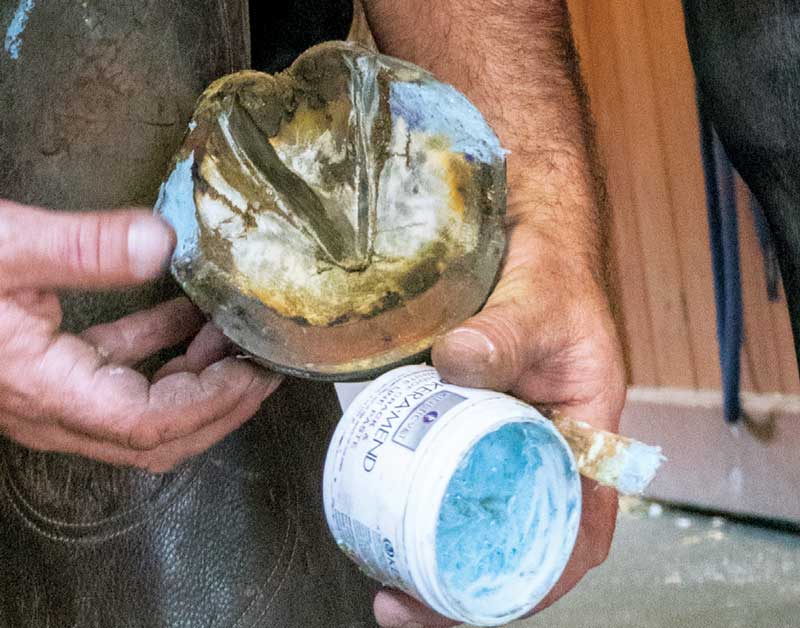
Before applying the shoe, Galli is mindful to address all significant hoof wall separations with Kera-Mend. He had good results with the product over the previous year.
Client’s Trust and Farrier’s Confidence
Galli has worked with Melvin for a couple of years. The hunter came wearing glue-ons, but has transitioned out of them. He says it is important to track changes and continually reassess to determine whether returning to glue-ons would help the shelly feet.
“This is a good example that if a horse is going to go well in aluminum, I would prefer to nail,” he says. “I’m fortunate with a client like this that I can make decisions on what I think is best without continually checking. Their concern is that the horse goes properly.”
As Mustello finishes Tokyo, Galli pulls Melvin’s right front shoe and starts to trim the foot. He decides to stick with the aluminum shoe with a pad and pour.
Having trimmed the forefeet, Galli takes a few different aluminum shoes to the foot to determine what would best suit the feet. He selects a #4 Century for the hunter.
Galli shapes the aluminum with the anvil positioned in the center of the trailer. Since he’s left-handed, Galli likes this layout because anyone on the crew can work on it. With a foot this size, and using this shoe with a pad, Galli says he can’t seat the clips properly, so he forges in some length on the clips. Before modifying the heels, he’s careful to cool the clips in the water bucket after taking them out of his forge. He does not want the heat to travel and break the clips.
Galli checks Mustello’s trim on the hinds. He questions him about the selection of the steel shoes and the ability to nail. Galli says he would prefer not to glue, but encourages Mustello to consider other options, like double clipping the shoe. He wants Mustello to make the decision, but won’t hesitate to intervene if the horse doesn’t respond well. The only recommendation Galli makes is considering a 25-by-10 shoe rather than the 22-by-10 Mustello was fitting.
“Make sure to draw those clips above the chipped hoof wall,” Galli says. “If I have to put glue or epoxy in there, I will, but I prefer stabilizing the hoof capsule simply with the shoe.”
We don’t correct the foot, we protect the foot …
During the day, Galli encourages Mustello to take on different tasks, like trimming hinds or shaping hind shoes. This is intentional — Galli believes the more trust you place in associates, the more confidence they develop, and the more enthusiasm they’ll put into their work. He isn’t a stickler that an associate is always busy either. If someone needs to stand around for a few minutes, then jumps into work that maintains their schedule, he’d prefer that to simply being busy on something less substantial that could delay a more important task.
To build a good team, Galli says start with someone who can take direction and constructive criticism. Show horse farriers will work with a variety of equine professionals who can be blunt with opinions. Galli warns against taking critiques personally. He also wants someone with horse handling experience and who is respectful to the barn workers.
“These grooms are the backbone of where we work,” he says. “Treat them like gold and it will return to you.”
Galli trains associates to be aware of their interaction with the horse and the impression it creates with a client. For example, guide the foot off the hoof stand rather than simply dropping it, because clients may view the action differently. This is important after nailing, when dropping the foot could result in an unclinched nail nicking the other leg.
Mustello will start on Pancho, another jumper headed back out on the road. Going back to the fronts, Galli fits the pad and shoe. He drills two holes in the toe area of the leather pad to help relieve pressure as the pour migrates forward.
With the shoes on and the pour in place, each foot is coated with Polyflex Seal-It Adhesive.
“It helps shelly-walled horses like this,” he says. “When I trim the horse next time, I’ll still see some of the varnish on the foot. At a horse show, these hunters could be bathed multiple times a day. That’s why I’m resistant to patching with acrylic. The water can get behind there and create problems.”
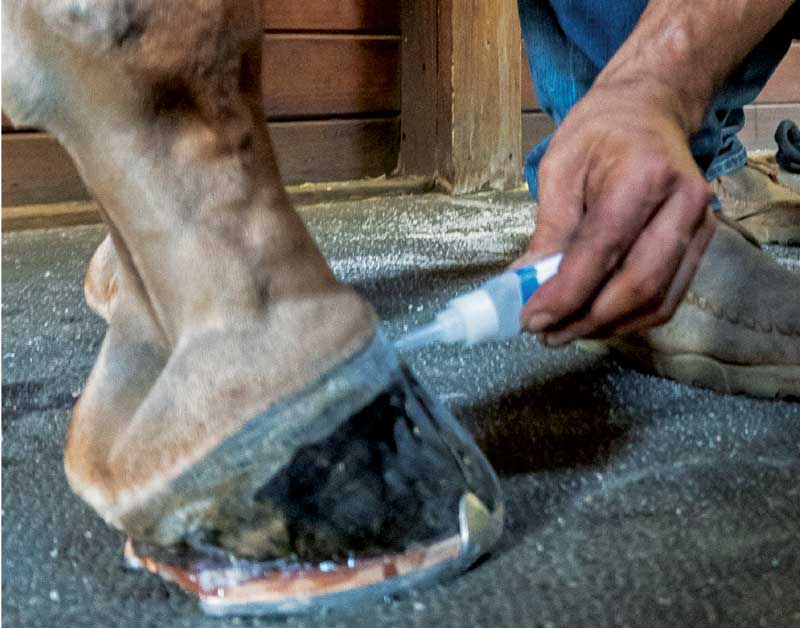
Galli finds rubbing Polyflex Seal-It Adhesive to the hoof wall can benefit compromised hoof walls that could become further damaged because of excessive bathing.
Delegate to Your Benefit
As Mustello finishes Pancho’s reset, Galli says he doesn’t manage his billing. He’s hired a local bookkeeper familiar with independent contractors to manage the invoicing. iForge Ahead is cloud-based so he can quickly look at the invoices before the bookkeeper emails them to clients. This system has improved cash flow by changing from monthly to weekly invoicing. Of course, there is a cost associated with using a service as such, but Galli recommends it as a means to improve business cash flow.
“In particular, if you work a boarding barn and bill to individual customers throughout the month, you might find yourself 60 days out from payment if you bill at the end of the month, but provided service at the beginning of the month.”
The bookkeeper handles other responsibilities like payroll, adding new horses, change of address and other administrative duties. He gets a copy of every incoming or outgoing email and if a question arises specific to a horse, he can address it. Galli reviews key performance indicators, monitors the bank accounts, incoming invoices for the business and the aging report. Galli acknowledges that a bookkeeper doesn’t fit every farrier business, but for one with his volume of clients and staffing needs, he sees it as a wise investment.
“It frees up a lot of my time,” he says. “It is the best money this business spends. She catches things that I would likely miss.”
Providing Cover
After leaving Findlay’s Ridge, Galli makes a quick stop to Old Salem Farm. He needs to tack on a shoe for a client competing. He typically won’t charge, being more concerned of potential damage caused by a lost shoe. There is none, so tacking the shoe on is quick work. The horse is just about due, but Galli will wait, not wanting to shoe amid the business of a horse show.
Galli will make another quick stop to nail on a shoe for a friend who is out of the country. Again, he won’t charge. He is against charging someone else’s client and also would appreciate the return of a cover if he was unavailable.
Leaving this barn, Galli notes that this was close to an average day. They may typically do 8-10 horses working as a pair, sometimes more. It all depends. As Galli explained before, working with these horses requires flexibility and a laid back approach.
Considering the demands and pressures applied from clients’ desire to compete, that can be challenging. But on this “Shoeing for a Living” day, Galli has shown that skill and knowledge are only part of the hoof-care puzzle. The ability to support all involved in the welfare of the horses on your books will contribute to your success

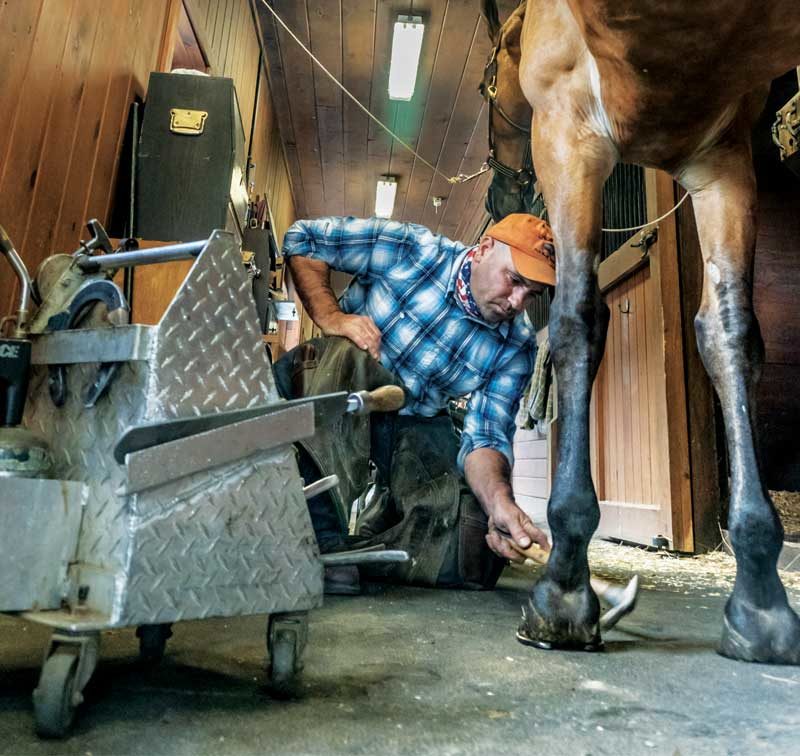







Post a comment
Report Abusive Comment